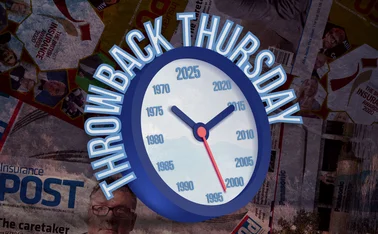
Top 30 European insurers 2016: At the top of their game

A lack of large natural disasters, favourable exchange rates and a number of sizeable mergers have seen many of the top 30 European insurers weather the tough environment and climb the rankings
The insurance companies that moved up this year’s European top 30 ranking have outperformed in what continues to be a testing market, boosting their results through a combination of slick strategic moves and a dollop of good fortune, as positive movements in exchange rates contributed to significant gains in gross written premiums for a number of Europe’s top insurance groups.
AM Best’s top 30 European ranking, published for the second year by Post, analyses the main drivers behind movements in market position and financial performance of non-life insurers domiciled in Europe, ranking them according to GWP. It does not include life or health insurers and excludes groups that are solely focused on reinsurance. It does, however, include insurers that write reinsurance if it is not their primary focus.
All the insurers included in the ranking are headquartered in Europe but are typically multinational players with an international book of business. We have assessed their earnings in euros to provide a consistent benchmark for comparison.
There were no dramatic downward movements in the 2015 ranking compared to 2014, aside from those shunted downwards as others moved upwards in the ranking. Lloyd’s, XL Group, Helvetia Holdings, Grupo Catalana Occidente and Allied World Assurance Company were the biggest climbers, with year-on-year premium increases of 12.2%, 52.9%, 39.9%, 15.1% and 17.2% respectively.
This suggests an overall stable picture among Europe’s top 30, with strong balance sheets and sound fundamentals for the majority of insurance companies that are successfully navigating a tough operating environment. However, there is no doubt that high levels of competition, low investment returns and the drive for capital efficiencies continue to test the market, with firms doubly focused on making positive technical underwriting returns.
Slightly higher combined operating ratios are a recurrent theme in 2015 in comparison to 2014 and undeniably margins remain tight. On the plus side, relatively benign natural catastrophe losses in 2015 and prior-year reserve releases have helped to bolster results for a number of insurers, softening the impact of low investment returns and the continued downward pressure on premium rates in many classes, with the exception of casualty and specialty lines.
Exchange rate movements are another factor that continued to affect the performance of Europe’s top 30 insurance companies, with Lloyd’s and Helvetia among those benefiting from significant appreciation of the dollar, pound and Swiss franc against the euro in 2015. Looking ahead, the Brexit vote could impact groups with a presence in the UK in a number of ways, as a result of exchange rate movements, passporting rights and regulatory considerations.
Stable performance despite myriad challenges
Among those insurers that have moved up in this year’s ranking is Lloyd’s, which moved from fourth position in 2014 to second position in 2015, reflecting a 12.2% growth in GWP in euro terms. A significant proportion of Lloyd’s premium income is dollar-denominated and both the dollar and the pound appreciated strongly against the euro.
However, Lloyd’s also saw a decline in profits resulting from lower investment returns and an increase in expenses, largely linked to its continued strategic expansion overseas. Among other activities, in 2015 the corporation opened an office in the Dubai International Financial Centre, expanded its operations in Singapore and opened branch and representative offices in Beijing, Mexico City and Bogota.
While Lloyd’s COR increased to 90% in 2015, up from 88.4% in 2014, reflecting increasingly difficult market conditions, the result is still positive and compares favourably to many of its peers. Technical results have benefited from favourable prior-year reserve development, mainly driven by reinsurance operations or specialty lines of business. Another year of below-average experience for natural catastrophe claims also contributed to the market’s results in 2015.
Pro-forma figures following the $28bn (€25bn) ‘merger of equals’ between Chubb and Ace reveal GWP of €25.24bn for 2015. Figures are not available for 2014 – the comparatives within the table are for the legacy Ace Limited company only.
However, the mega tie-up between the two major insurance players, which completed in mid-2016, has seen the new heavyweight player rising three places in the ranking to fifth place.
The combined businesses are both well-established players in the commercial non-life market and within specialty lines, with complementary business models. While committed to supporting its European business, Chubb is also continuing its global expansion into new markets in Asia, Latin America and niche businesses within the US.
Another outperformer in this year’s European top 30 was XL Group, which moved from 16th position in 2014 up to 12th position in 2015 following a 52.9% increase in premiums. Profits after tax were also up substantially, from €221m in 2014 to €1.2bn for full year 2015. The improvement in results is largely reflective of the group’s $4.28bn (€3.84bn) merger with Catlin, which completed in May 2015.
As with the Chubb/Ace transaction, the main driver behind XL and Catlin’s merger was to obtain increased capital efficiencies, greater scale and access to broader distribution networks and a more diverse product range. The combined firms are continuing to build upon existing synergies, revealing capital efficiency savings will reach around $500m (€448m) by the end of 2017, up from their initial estimate of $200m (€179m). The firm is continuing to expand its international presence as well as its range of specialty products and services.
Another insurance group to benefit from positive exchange rate movements was Swiss-based Helvetia Holdings, which moved up 15 places in the ranking to 27th position overall after a 40% rise in GWP. The growth in GWP was partially assisted by the significant appreciation of the Swiss franc, which soared against the euro after the Swiss central bank abandoned its exchange rate control.
The insurer’s results continued to be positively influenced by the integration of Nationale Suisse and Basler Austria, which it acquired in 2014. However, net profits were down year-on-year, dented by the costs emanating from these acquisitions.
A second broad category within this year’s top 30 are those firms that experienced growth in both GWP and results even though this was not reflected in upward movement in the ranking. In spite of moving down a notch from second to third position – reflecting Lloyd’s jump into second place – Axa has continued to demonstrate resilient profit margins in 2015.
The French insurer experienced a 6.3% growth in premiums and saw an increase in net profits to €5.9bn. It has benefited from exchange rate movements and its continued growth in international markets, especially within its assistance business mainly with third-party clients. The group continues to invest in small businesses in emerging markets, including Brazil, Poland, China and India.
Meanwhile, HDI was another beneficiary of positive exchange rate movements, which were responsible for half of its 14.2% growth in GWP year-on-year. While the German-based insurer maintained its ranking in 9th position in 2015, the group also experienced a modest increase in net profit. Strong fundamentals reflect in its improved COR in most segments, as a consequence of corrective actions on its industrial property business, which had been underperforming in the immediate previous years. The insurance company has continued its strong push for growth in Latin America, somewhat offset by economic and regulatory challenges both in Turkey and Poland.
With no dramatic drops in the 2015 ranking, a final grouping can be made among those within the top 30 whose businesses have remained largely flat year-on-year.
First up is Zurich, with a marginal 1.2% increase in GWP but significant decline in profits, reflecting challenges within its global corporate business following large losses and two profit warnings in 2015. The losses, including flood claims, drove a disappointing COR of 104% for the year.
The insurer has taken steps to return to profitability by reducing its expenses and improving the efficiency of its footprint. Among initiatives brought in by recently appointed CEO Mario Greco is the decision to merge Zurich’s life and general insurance divisions. The company is also in the process of realigning its business in other ways, divesting of businesses in some non-core markets – including Morocco and Taiwan – and investing in others.
Meanwhile, Generali and Groupama have maintained a flat year-on-year GWP but experienced an improvement in results. For Generali this reflects an improved underwriting performance and premium declines in Italy and France due to high competition and stricter underwriting guidelines. On the other hand, the firm has seen slight increases in premium volume from Germany, Eastern Europe and Spain with healthy combined ratios in Italy, Germany and Eastern Europe. In France, despite material improvements, the COR was still slightly above 100% in 2015.
Similarly, Groupama experienced a modest premium rise within property and casualty insurance in France as well as in some key international markets, combined with improvements in profits. This reflects below average loss activity, solid growth within professional risks and home insurance in France and agricultural insurance in Turkey, contributing to an overall non-life COR ratio of 99.2% for 2015. This was partially offset by a deterioration in motor insurance in Italy, Greece and Turkey, due to legislative changes and difficult market conditions.
Maintaining momentum
The need to deploy excess capital and allocate it efficiently remains a key focus in what is still a highly competitive environment with abundant capacity. Material transactions, such as those between Chubb and Ace or XL and Catlin, cannot be ruled out but are less likely due to the already high concentration among the largest players in the market. Further consolidation among medium-sized insurers is more likely in the bid for scale and cost efficiencies.
In addition to capital efficiency, greater scale also offers the ability to pursue more aggressive investment strategies in the persisting low interest rate environment. The top 10 players continue to allocate more of their investment portfolio to equities and property, such as infrastructure projects, however, these alternative investments are being undertaken with due caution and conservatism.
Insurers in the top 30 continue to push for overseas expansion, primarily into emerging markets in Latin America, Eastern Europe and Asia-Pacific, growing both organically and through strategic mergers and acquisitions. A greater international presence is enabling Europe’s top 30 players to better serve their multinational clients and to grow a presence in markets where insurance growth is outstripping GDP growth.
In addition, a number of groups with solid track records in personal lines are expanding their commercial propositions. Allianz, Axa, Mapfre and Aviva are among those in the top 30 that continue to strengthen or are developing a broader range of products in commercial and specialty lines to serve European and international clients. As their business profiles adapt in this way, we are observing increased appetite for collaboration with the largest reinsurers, both in regard to reinsurance protection and technical assistance.
Only users who have a paid subscription or are part of a corporate subscription are able to print or copy content.
To access these options, along with all other subscription benefits, please contact info@postonline.co.uk or view our subscription options here: http://subscriptions.postonline.co.uk/subscribe
You are currently unable to print this content. Please contact info@postonline.co.uk to find out more.
You are currently unable to copy this content. Please contact info@postonline.co.uk to find out more.
Copyright Infopro Digital Limited. All rights reserved.
As outlined in our terms and conditions, https://www.infopro-digital.com/terms-and-conditions/subscriptions/ (point 2.4), printing is limited to a single copy.
If you would like to purchase additional rights please email info@postonline.co.uk
Copyright Infopro Digital Limited. All rights reserved.
You may share this content using our article tools. As outlined in our terms and conditions, https://www.infopro-digital.com/terms-and-conditions/subscriptions/ (clause 2.4), an Authorised User may only make one copy of the materials for their own personal use. You must also comply with the restrictions in clause 2.5.
If you would like to purchase additional rights please email info@postonline.co.uk







